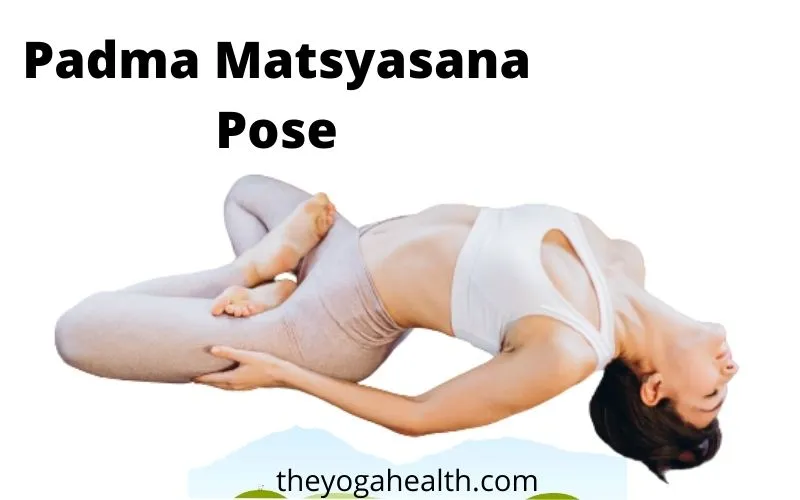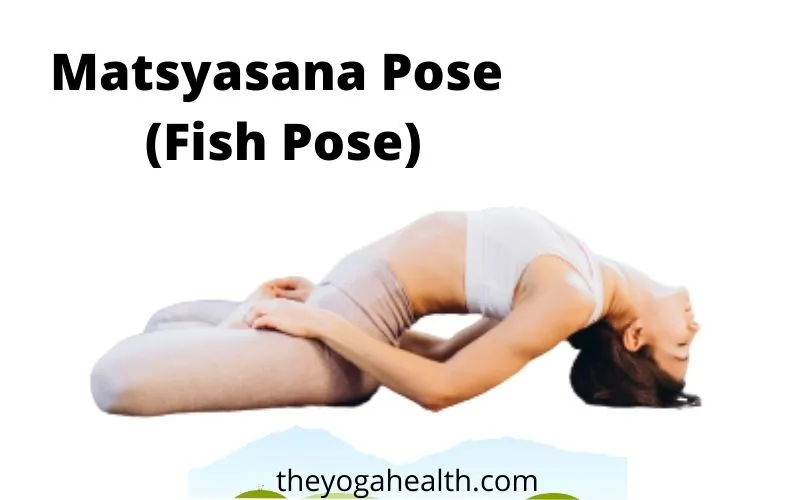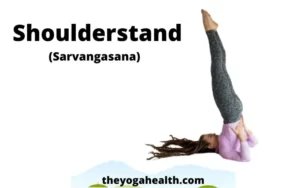In the vast ocean of yoga asanas, Fish Pose, or Matsyasana in Sanskrit, stands out as a beautiful and serene pose. In this article we will dive into the depths of Fish Pose, understanding its significance, benefits, and the profound impact it can have on your yoga practice.
This heart-opening asana not only stretches the chest and throat but also nurtures the mind and spirit.Whether you’re a newcomer to yoga or seeking to expand your practice, this article will lead you to explore the real beauty of this Pose.
Table of Contents
Fish Pose (Matsyasana)
Fish Pose, named after the aquatic creature, reflects the graceful form of a fish swimming in water. In this asana, the chest is elevated, the heart opens, and the throat is stretched, creating a sense of expansion and vulnerability. This Pose is often practiced as a counter pose to other backbend poses, providing balance and harmony to the yoga practice.
Meaning of Matsyasana
‘Matsya’ in the Sanskrit language means a ‘fish’. This asana is dedicated to ‘Matsya Avatar’ who is believed to be a ‘Fish’ carnation of Bhagwaan Vishnu.
Bhagwan Vishnu is known as the source and maintainer of the universe. As per the Indian folklore, once upon a time, the whole earth had become very corrupt and the earth was to be flooded. Then Bhagwan Vishnu incarnates in the form of a fish and warned ‘Manu’ about the coming flood.
The fish then carried Manu and his family and Seven Great Sages in a ship. The ship was fastened to a horn on the head of the Fish. Vedas were also saved from the flood by the ‘Manu’. Matsyasana is a base pose for all Matsyasana variations that can be derived from this pose.
Fish Pose Basic Details:
| Sanskrit Name | Matsyasana |
| English Name | Fish Pose |
| Difficulty Level | Beginner |
| Position | Back Bend |
The Significance of Fish Pose
Fish Pose holds spiritual significance in yoga, symbolizing the element of water, which represents emotions, intuition, and fluidity. By assuming the form of a fish, practitioners are encouraged to embrace vulnerability and release emotional tensions, allowing the heart to be fully exposed and open to love and compassion.

Matsyasana for Beginners
1. Start by lying down flat on the Yoga mat. Now stretch your arms and legs out and relax your body.
2. Now bring your hands under your hips, your palms should be facing the floor, and bend your arms at the elbow. Now place your elbows close to your body on the floor.
3. Now breathe in and raise your entire upper body and very slowly place the crown of your head on the floor by bending your head backward. Breathe out completely when you place the crown of your head on the floor.
4. Now breathe out and push your elbows on the floor, arch your back while raising your chest upwards. Curve your body back as you lower your head onto the floor.
5. The lower body from buttocks to the heels should be firmly on the floor and not raised.
6. Now with the help of your abdominal muscles raise your body upwards and ensure that the weight of your body is not on the neck or head, but is on your elbows, hips, and core.
7. You can stay in this pose for as long you as feel comfortable with long and long breathing.
8. To come out of this pose, slowly raise your head up, lower your chest and head on the floor and bring your hands back to the sides of your body.
9. After the pose you can relax for some time in Savasana.
Matsyasana Modifications:
These few Matsyasana modifications can help you to do this asana without putting much pressure on your muscles.
1. Blanket under your head. You can place a blanket under your head to give a better stretch to your lower back and neck.
2. Blanket under your hips. You can also place a blanket under your hips to reduce pressure on the hips.
3. Bolster under your Shoulders. You can also place bolsters under your lower shoulders that can help take the head back with ease.
4. One-Legged FishPose: Lift one leg off the ground while in this Pose to add an extra stretch to the hip flexors and quadriceps.
Yoga Fish Pose can offer specific benefits for certain health conditions:
Relieving Anxiety and Depression: The heart-opening aspect of this Pose can help alleviate symptoms of anxiety and depression by releasing pent-up emotions and promoting emotional well-being.
Alleviating Neck and Shoulder Pain: The gentle stretch and strengthening of the upper back in this Pose can alleviate tension and discomfort in the neck and shoulders.
Easing Respiratory Issues: The expansion of the chest and opening of the lungs can improve respiratory function and help with conditions like asthma and bronchitis.
Padma Matsyasana

Those who can perform Padmasana can do this variation of Matsyasana with Padmasana that is more beneficial than the earlier pose. This is an advanced yoga pose and should be performed under the guidance of a qualified yoga teacher.
Padma Matsyasana Steps
1. Sit in the Padmasana Pose on your Yoga mat.
2. Now lie flat on the back with your legs on the floor.
3. Now breath out, arch your back by raising your neck and your chest. Now take your head back and rest your crown of the head on the yoga mat.
4. Now move your head further back by holding your crossed legs with your hands and increasing the arch of your back.
5. Now take your hands from the legs and bend your arms.
6. Now hold the elbows with your hands and place your forearms on the floor behind your head.
7. You can hold this position for about 30 seconds to 1 minute with deep breathing.
8. Now rest the back of your head on the floor and lie flat on the floor. Now breathe in and come up in the Padmasana pose and release your legs and relax.
9. Now re-cross your legs the other way around and repeat the pose for the same time duration.
10. If the above-mentioned position is difficult to perform then one can lie flat on the back with his arms stretched straight over the head.
Fish Pose Benefits:
1. Stretches dorsal area: The dorsal area is fully stretched in this pose and the chest is fully expanded.
2. Deep full capacity breathing: It is said that man is as strong as his lungs are. The practitioner is able to breathe deeply to his maximum capacity and increases lungs capacity. This pose also gives relief from respiratory disorders through deep breathing.
3. Helps in Thyroid: People suffering from Thyroid problems get benefitted from this pose due to stretching of the neck.
4. Give strength to back muscles: In this pose the spine is curved when a person bends backward, it greatly strengthens the back muscles when an arch is formed.
5. Increases elasticity in the pelvic area: The joints of the pelvic become elastic.
6. Helpful in increasing Blood to Glands: This pose increases the supply of blood to the thoracic regions that help the proper functioning of pituitary and pineal glands.
7. Helpful in Piles: This asana relieves bleeding and inflamed piles.
8. Stiffness of Neck and Shoulders: The regular practice of this pose brings down the stiffness and tensions in the neck and shoulders of the practitioner.
9. Spondylitis: It can also prevent cases of initial stages of spondylitis but it is advisable to practice this pose under the expert guidance of a qualified Yoga teacher.
Fish Pose yoga Contraindications:
1. People suffering from high or low blood pressure should avoid this pose.
2. If a person is suffering from a problem of severe spondylitis then he can avoid this pose. Although spondylitis of initial stages can be cured with regular practice of Matsyasana it is advisable to always do it under the expert guidance of a Yoga teacher.
3. Pregnant women should also avoid this pose.
4. If a person is having any kind of injury in the neck or any part of the lower back then he should avoid this pose.
5. People having any sort of heart problems should avoid this pose cause they may find it uncomfortable to perform.
Conclusion:
Fish Pose, with its heart-opening nature and gentle backbend, offers a serene and transformative experience in your yoga practice. As you explore the depths of this beautiful asana, you’ll discover the power of vulnerability, compassion, and self-awareness.
Remember that yoga is a journey of self-discovery, and Fish Pose serves as a reminder to embrace the serenity within. So, immerse yourself in the tranquility of Fish Pose and let it guide you towards a more open heart, a calmer mind, and a deeper connection with yourself and the world around you.
Matsyasana is an easier pose than the various other backbend poses of Hatha Yoga so those people who are new to Yoga must include this pose in their daily practice. This pose if carried out in the water will allow the body to float easily just like a fish, hence the name Fish Pose.
FAQ: Fish Pose
Q1. How long to perform fish pose?
Ans: Fish pose is an easier pose to perform, one can stay in this pose as long as they feel comfortable. But if you are performing Padma Matsyasana then you can hold this pose from 30 seconds to about 1 minute.
Q2. Can Matsyasana cure spondylitis?
Ans: In the initial stages of spondylitis, performing Matsyasana may be helpful but if a person is suffering from a severe case of spondylitis then he should avoid doing Mastsyasna. In any case, all people with spondylitis problems must perform this asana under the expert guidance of a Yoga teacher.
Q3. Should pregnant women do a fish pose?
Ans: No, it is not advisable for pregnant women to do the fish pose.
Share your experience of performing Matsyasana with other users and if you have any questions then you can ask in the comments section below.





